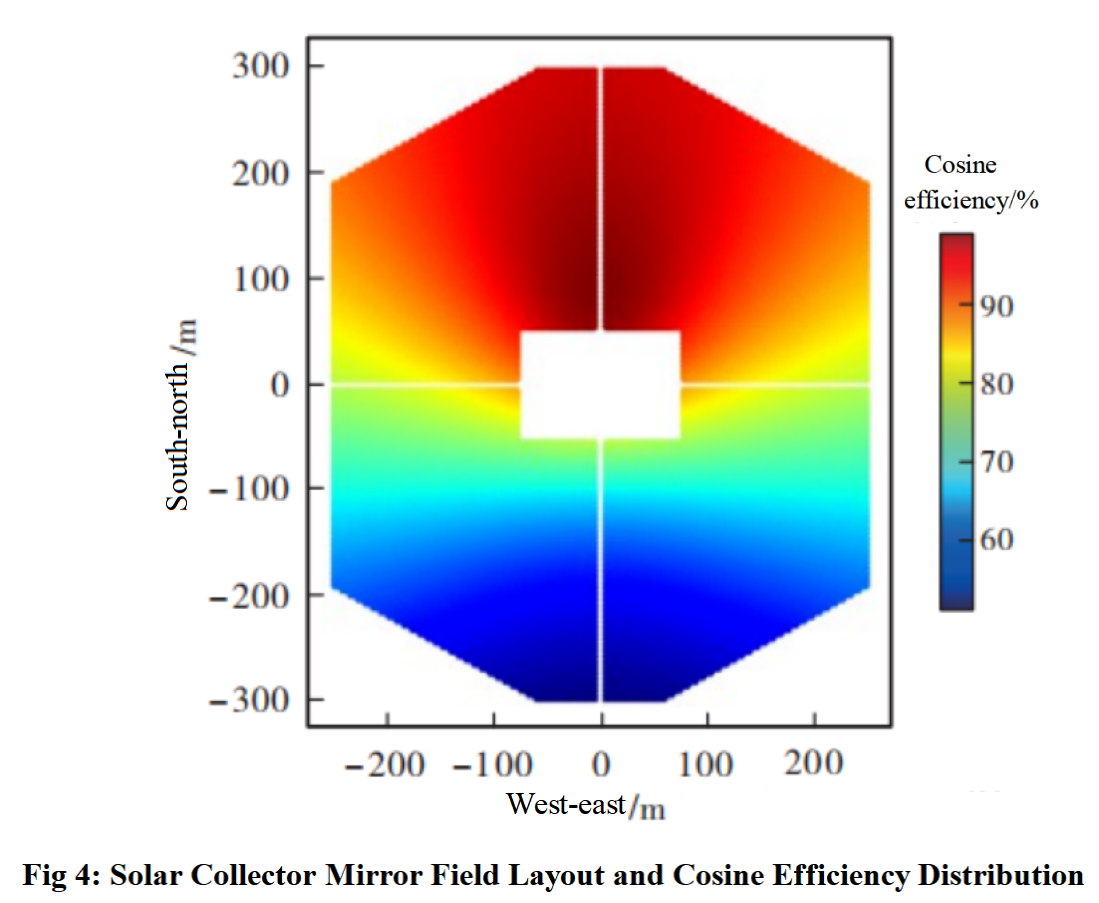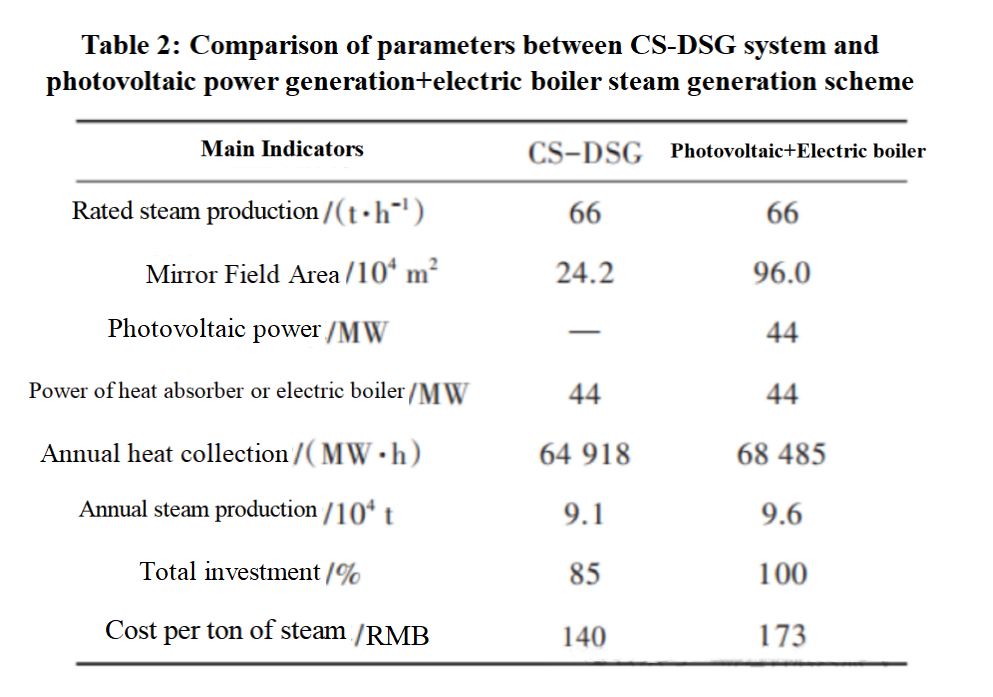Solar High-temperature Photothermal Technology Empowers Low-carbon Development of Shallow Ultra Heavy Oil (Part 2)
The heavy oil operation area developed using SAGD technology can use a high-temperature photothermal direct steam production (CS-DSG) system coupled with steam injection boilers to carry out photothermal steam production, injecting steam through variable flow rate. To analyze the cost of photothermal steam production corresponding to different mirror field scales, four photothermal steam production output schemes of 20 t/h, 36 t/h, 66 t/h, and 200 t/h were selected to carry out the layout and system matching analysis of the collector mirror field. The results indicate that as the scale of the collector mirror field increases, the unit investment cost shows a downward trend, and the cost reduction is mainly due to the scale effect of the photothermal steam system. But when the scale of the mirror field increases to a certain extent, the efficiency of the system's photothermal conversion decreases, resulting in a decrease in heat collection and a corresponding decrease in steam production. The investment cost per ton of steam, which is equivalent to the entire life cycle, actually increases. The specific comparison of scheme parameters is shown in Table 1.

The third option in Table 1 has the best economic efficiency, with a steam production of 66t/h and a steam cost of 140 yuan per ton. It is expected to save 6.83 × 106m3 of natural gas and reduce 1.475 × 104t of carbon dioxide annually. To improve the optical efficiency and land use efficiency of the mirror field, a non circular mirror field layout is optimized, as shown in Figure 4.

By optimizing the mirror field layout, the overall cosine efficiency has been improved to 79.33%. CS-DSG technology directly converts solar radiation heat into thermal energy of the working fluid, and its photothermal conversion efficiency is much higher than that of photovoltaic power generation+electric boiler steam production. After comparing the solar thermal steam generation scheme with similar steam production rates and the photovoltaic power generation+electric boiler scheme (Table 2), it was found that:
① The annual heat collection is similar, and the steam production is similar. The area of the photothermal mirror field is only 1/4 of that of the photovoltaic array;
② The unit cost of the CS-DSG system is approximately 85% of the unit cost of the photovoltaic+electric boiler steam system;
③ The efficiency of photothermal conversion is twice that of photoelectric conversion.
The above differences are mainly due to the fact that the solar thermal conversion efficiency can reach 40% to 50%, while the solar photovoltaic conversion efficiency is only over 20%; Photovoltaic power generation generally uses fixed brackets, and to avoid excessive obstruction, the array spacing is relatively large.

Based on the above comparative analysis, for heavy oil operation areas that have adopted the SAGD process and have been developed for a period of time, the CS-DSG system can be coupled with existing steam injection boilers to achieve renewable energy substitution for some natural gas at a lower cost.
3. Photothermal Continuous Steam Production Solution
Compared to the SAGD process, other processes for heavy oil thermal recovery require relatively high requirements for continuous steam stability, or require the complete replacement of existing steam injection boilers with renewable energy. In this scenario, the high-temperature photothermal continuous steam production (CS-SGS) scheme should be considered. The CS-SGS system includes a spotlight heat collection system, a molten salt working fluid heat absorber, a molten salt heat storage system, a molten salt steam generation system, a steam water system, and an electrical and thermal control system. Compared to CS-DSG, it has added a molten salt heat storage system and a molten salt steam generation system, which is consistent with the process flow of the front-end steam generation system for solar thermal power generation, ensuring operational stability and reliability. The main problem is limited by the light resource conditions and the cost of the light thermal system in the oil region, resulting in poor substitution economy.
Drawing on the practices of thermal power plants and renewable energy bases, fully utilize valley power and wind and solar power curtailment to convert electrical energy into thermal energy and store it in molten salt. On the basis of the collector mirror field and molten salt storage system, an electrode heating molten salt device is added to achieve the coupling of the solar collector system with the electrode heating system for heating the molten salt. Fully utilizing tank capacity to increase heat storage capacity, increase steam supply capacity, and reduce steam costs by utilizing valley and curtailment electricity. Table 3 compares the CS-SGS system with the addition of a 40 MW electric molten salt heating system. The latter increases heat collection by 158%, and the capacity of the heat storage system increases from 132 MW·h to 300 MW·h, corresponding to an increase in heat storage duration from 6 h to 14 h. The annual steam production has increased from 8.2×104t to 21.2×104t, and the cost of steam per ton has been reduced from 240 yuan to 174 yuan.

This plan utilizes daytime solar thermal resources and nighttime valley power resources, and increases a certain amount of heat storage capacity on the basis of the tank capacity of the molten salt heat storage system, which can achieve stable steam supply on a large scale. The specific coupling configuration plan can be determined according to the on-site steam demand. At present, the construction of renewable energy supply facilities such as photovoltaics and wind power is being carried out. When wind and solar power reaches a certain stage of development, it will inevitably face problems between the consumption of renewable energy electricity, grid peak shaving, and wind and solar power curtailment. On the basis of implementing the scheme of replacing natural gas injection steam boilers with photothermal steam production, adding electric heaters and utilizing curtailment/valley electricity to carry out molten salt heat storage not only solves the problem of curtailment electricity, but also obtains green thermal energy required by the oilfield operation area. At the same time, it increases the user side load regulation ability, playing a multiple role.
